Page 235 of 340

.,. . I
Remove the theft deterrent
wheel nut, by placing the
key end of the wire wheel
key wrench over the nut
and turning it to the left.
Pull off the wire wheel
cover. Note: When
replacing the wheel cover,
carefully line up the tire
valve stem and the notch in
the wheel cover.
I
Using the wheel wrench, loosen all the wheel nuts.
Don’t remove them yet. Next, attach the wheel wrench
to the bolt on the end
of the jack. Raise the jack a little
by rotating the wheel wrench clockwise (to the right). Position the
jack under the
vehicle. There is a notch in
the frame near each
of the
wheels. Fit the top of the
jack into the notch nearest
the wheel with the flat tire.
The jack handle has markings at
8” for the rear and 10”
for the front, which will help you to locate the jacking
notches in the frame.
1 CAUTION:
Getting under a vehicle when it is jacked up is
dangerous.
If the vehicle slips off the jack, you
could be badly injured or killed. Never get under
le when it
is supported only by a jack.
ProCarManuals.com
Page 236 of 340
Raise the vehicle by rotating the wheel wrencn
clockwise. Raise the vehicle far enough
off the ground
so there is enough room for the spare tire to fit. Raising your vehicle with the jack improperly ~~
Remove all the wheel nuts and take off the flat tire.
ProCarManuals.com
Page 237 of 340
A CAUTION:
Rust or dirt on the wheel, or on the parts to
which
it is fastened, can make the wheel nuts
become loose after a time. The wheel could come
off and cause an accident. When you change a
wheel, remove any rust or dirt from the places
where the wheel attaches to the vehicle.
In an
emergency, you can use a cloth or a paper towel
to do
this; but be sure to use a scraper or wire
brush later,
if you need to, to get all the rust or
dirt
off.
kemove any rust or dirt from the wheel bolts, mounting
urfaces or spare wheel.
CAUTION:
Never use oil or grease on studs or nuts. If you
do, the nuts might come loose. Your wheel could
.
fall off, causing a serious accident. &:aF,;--..& ..*
I
ryr 2:. 74
&
Place the spare on the ~ .*. .. wheel mounting surface.
Replace the wheel nuts
with the rounded end
of the
nuts toward the wheel.
Tighten each nut
by hand
until the wheel
is held
lgainst the hub.
ProCarManuals.com
Page 238 of 340
Lower the vehicle by rotating the wheel wrench
counterclockwise. Lower the jack completely. Tighten the wheel nuts
firmly
in a criss-cross
sequence
as shown.
[ A CAUTION:
Incorrect wheel nuts or improperly tightened
wheel nuts can cause the wheel to become loose
and even come off. This could lead to an
accident. Be sure to use the correct wheel nuts.
If you have to replace them, be sure to get the
right kind.
Stop somewhere as soon as you can and have
the nuts tightened with a torque wrench to
100 ft.
Ibs.
(140 N.mh
ProCarManuals.com
Page 239 of 340

Don’t try to put a wheel cover on your compact spare
tire.
It won’t fit. Store the wheel cover in the trunk until
you have the
flat tire repaired or replaced.
I NOTICE:
Now put all the equipment back in the trunk.
WHEEL WRENCH
A CAU I ION:
Storing a jack, a tire or other equilpment in the
passenger compartment of the vehicle could
cause injury. In a sudden stop or collision, loose
equipment cowtd strike someone. Store all these
in the proper
place.
Compact Spare Tire
Although the compact spare was fully inflated when
your vehicle was new, it can lose air after a time. Check
the inflation pressure regularly. It should be
60 psi (420
kPa). The compact spare is made to go up to 3,000 miles
(5000 km), so you can finish your trip and have your
full-size tire repaired
or replaced where you want. Of
course, it’s best to replace your spare with a full-size tire
as soon as you can. Your spare will last longer and be in
good shape
in case you need it again.
Your anti-lock brake system warning light may come on
when
you are driving with a compact spare. See
“Anti-Lock Brake System Warning Light’’ in the Index.
237
ProCarManuals.com
Page 240 of 340
Don't take your compact spare through an
automatic car wash with guide rails. The
compact spare can get caught on the rails. That
can damage the tire and wheel, and maybe other
Don't use your compact spare on some other vehicle.
And don't
mix your compact spare or wheel with other
wheels or tires. They won't
fit. Keep your spare and its
wheel together.
Tire chains won't fit your compact
them will damage your vehicle and destroy
the
chains too. Don't use,.,,tjce: , , .,,b :" 'ix., chains on you
compact spare. ,., (,:, ,.,4'#i ,, . .Ai v*: ,, j '2
L
/d CAUTION:
Storing a jack, a tire, or other equipment in the
passenger compartment of the vehicle could
cause injury. In a sudden stop or collision,
loose
equipment could strike someone. Store all thesc
in the proper place.
238
ProCarManuals.com
Page 241 of 340

If You’re Stuck: In Sand, Mud, Ice or
Snow
What you don’t want to do when your vehicle is stuck is
to spin your wheels. The method known as “rocking” can
help
you get out when you’re stuck, but you must use
caution.
I A CAUTION:
If you let your tires spin at high speed, they can
explode and you or others could be injured. And,
the transaxle or other parts of the vehicle can
overheat. That could cause an engine
compartment fire or other damage. When you’re
stuck, spin the wheels as little as possible. Don’t
spin the wheels above
35 mph (55 km/h) as
shown
on the speedometer.
I = I
Spinning your wheels lestroy par __ of your
vehicle as well as the tires. If you spin the whe
too fast while shifting your transaxle back
forth, you can destroy your transaxle.
Rocking your vehicle to get it out:
First, turn your steering wheel left and right. That will
clear the area around your front wheels. Then shift back
and forth between
“R” (Reverse) and a forward gear,
spinning the wheels as little as possible. Release the
accelerator pedal while you shift, and press lightly on
the accelerator pedal when the transaxle is
in gear. If
that doesn’t get
you out after a few tries, you may need
to be towed out.
If you do need to be towed out, see
“Towing Your Car”
in the Index.
ProCarManuals.com
Page 274 of 340
When to Check: Check your tires once a month or
more.
Don’t forget your compact spare tire. It should be at
60
psi (420 Ha).
How to Check: Use a good quality pocket-type gage to
check tire pressure. Simply looking
at the tires will not
tell you the pressure, especially
if you have radial tires --
which may look properly inflated even if they’re
underinflated.
i
If your tires have valve caps, be sure to put them back
on. They help prevent leaks by keeping out dirt and
moisture.
Tire Inspection and Rotation
To make your tires last longer, have them inspected and
rotated at the mileages recommended
in the
Maintenance Schedule. See “Scheduled Maintenance Services” in the Index. Use
this rotation
pattern.
After the tires have been rotated, adjust the front and
rear inflation pressure as shown on the Tire-Loading
Information label. Make certain that all wheel nuts are
properly tightened. See “Wheel Nut Torque”
in the
Index.
ProCarManuals.com